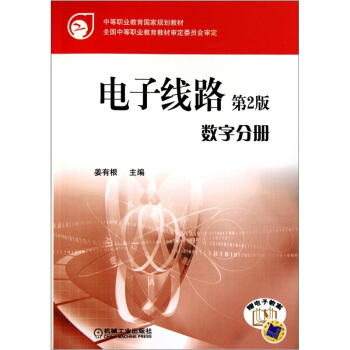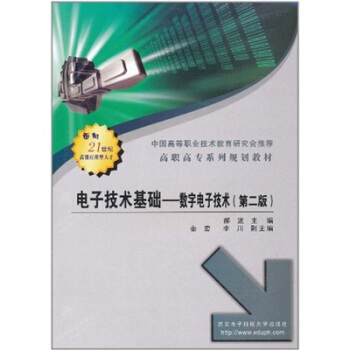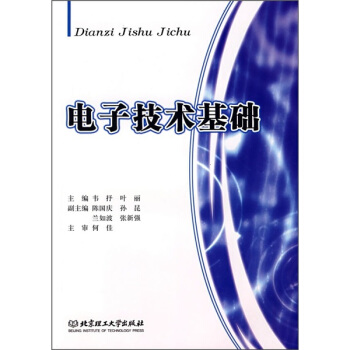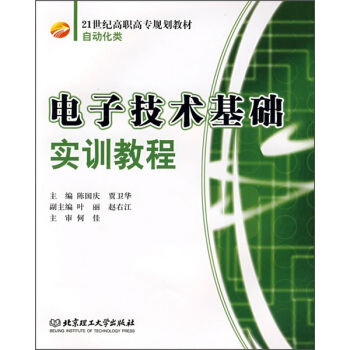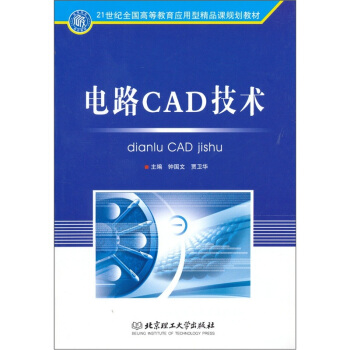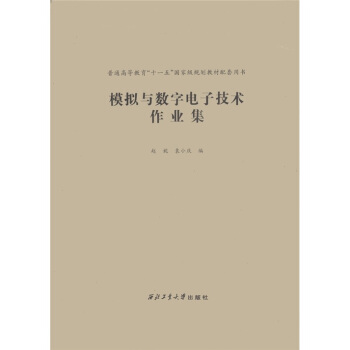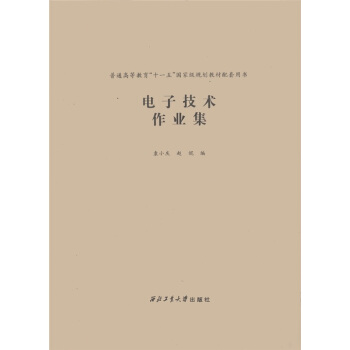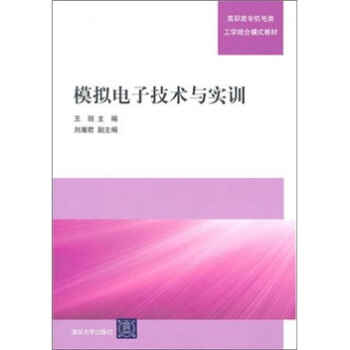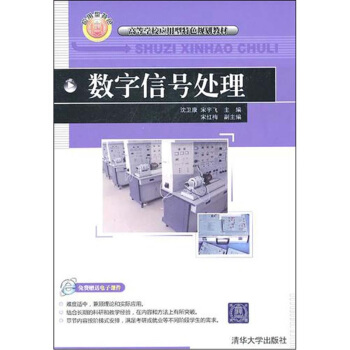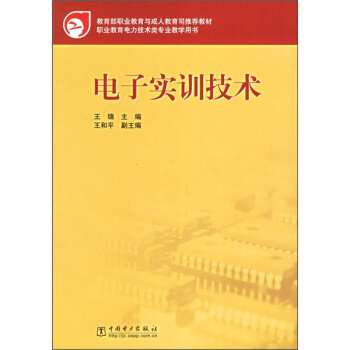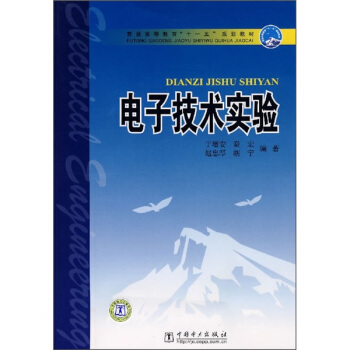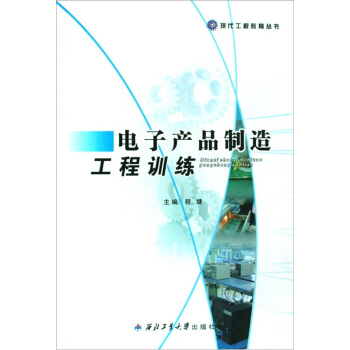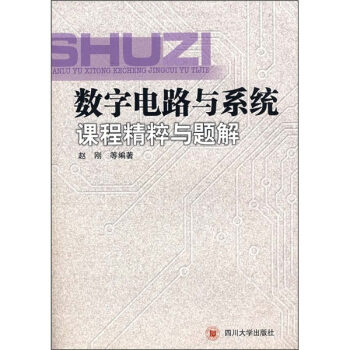

具体描述
内容简介
《数字信号处理(第2版)(英文版)》系统地阐述了数字信号处理所涉及的信号与系统分析和系统设计的基本理论、基本分析与设计方法、基本算法和处理技术。《数字信号处理(第2版)(英文版)》共10章,主要内容包括:离散时间信号与系统的基本概念,离散时间信号与系统的变换域分析,包括z变换和离散时间傅里叶变换、连续时间信号的抽样与重建,离散傅里叶变换及其快速算法(fft),数字滤波器实现的基本结构,iir和fir数字滤波器的设计原理与基本设计方法,数字信号处理中的有限字长效应,多抽样率数字信号处理。《数字信号处理(第2版)(英文版)》配有多媒体电子课件、英文版教学大纲、习题指导与实验手册。《数字信号处理(第2版)(英文版)》可以作为电子与通信相关专业的本科数字信号处理课程中英文双语教学的教材,或中文授课的英文版教学参考书,也可供从事数字信号处理的工程技术人员学习参考。《数字信号处理(第2版)(英文版)》尤其适合初步开展数字信号处理课程中英文双语授课的师生选用。
作者简介
蔡坤宝博士,重庆大学通信工程学院教授,信号与信息处理硕士学位点负贵人。长期从事信号与信息处理的教学与科研工作。近十余年来,积极探索和实施中英文双语教学,现任重庆大学大类系列课程“信号与系统”建设项目负责人,重庆市精品课程“信号与线性系统”负责人、国家级双语教学示范课程“信号与系统”负责人,并承担重庆市精品课程“数字信号处理”的建设工作。目录
1 introduction
1.1 what is a signal?
1.2 what is a system?
1.3 what is signal processing?
1.4 classification of signals
1.4.1 deterministic and random signals
1.4.2 continuous-time and discrete-time signals
1.4.3 periodic signals and nonperiodic signals
1.4.4 energy signals and power signals
1.5 overview of digital signal processing
2 discrete-time signals and systems
2.1 discrete-time signals: sequences
2.1.1 operation on sequences
2.2 basic sequences
2.2.1 some basic sequences
2.2.2 periodicity of sequences
2.2.3 representation of arbitrary sequences
2.3 discrete-time systems
2.3.1 classification of discrete-time systems
2.4 time-domain representations of lti systems
2.4.1 the linear convolution sum
2.4.2 interconnections of lti systems
2.4.3 stability condition of lti systems
2.4.4 causality condition of lti systems
2.4.5 causal and anticausal sequences
2.5 linear constant-coefficient difference equations
2.5.1 recursive solution of difference equations
2.5.2 classical solution of difference equations
2.5.3 zero-input response and zero-state response
2.5.4 the impulse response of causal lti systems
2.5.5 recursive solution of impulse responses
2.5.6 classification of lti discrete-time systems
problems
3 transform-domain analysis of discrete-time signals and systems
3.1 the z-transform
3.1.1 definition of the z-transform
3.1.2 a general shape of the region of convergence
3.1.3 uniqueness of the z-transform
3.2 relation between the rocs and sequence types
3.3 the z-transform of basic sequences
3.4 the inverse z-transform
3.4.1 contour integral method
3.4.2 partial fraction expansion method
3.4.3 long division method
3.4.4 power series expansion method
3.5 properties of the z-transform
3.6 the discrete-time fourier transform
3.6.1 definition of the discrete-time fourier transform
3.6.2 convergence criteria
3.6.3 properties of the discrete-time fourier transform
3.6.4 symmetry properties of the discrete-time fourier transform
3.7 transform-domain analysis of lti discrete-time systems
3.7.1 the frequency response of systems
3.7.2 the transfer function of lti systems
3.7.3 geometric evaluation of the frequency response
3.8 sampling of continuous-time signals
3.8.1 periodic sampling
3.8.2 reconstruction of bandlimited signals
3.9 relations of the z-transform to the laplace transform
problems
4 the discrete fourier transform
4.1 the discrete fourier series
4.2 properties of the discrete fourier series
4.2.1 evaluation of the periodic convolution sum
4.3 the discrete fourier transform
4.4 properties of the discrete fourier transform
4.4.1 circular convolution theorems
4.5 linear convolutions evaluated by the circular convolution
4.6 linear time-invariant systems implemented by the dft
4.7 sampling and reconstruction in the z-domain
4.8 fourier analysis of continuous-time signals using the dft
4.8.1 fourier analysis of nonperiodic continuous-time signals
4.8.2 practical considerations
4.8.3 spectral analysis of sinusoidal signals
problems
5 fast fourier transform algorithms
5.1 direct computation and efficiency improvement of the dft
5.2 decimation-in-time fft algorithm with radix-2
5.2.1 butterfly-branch transmittance of the decimation-in-time fft
5.2.2 in-place computations
5.3 decimation-in-frequency fft algorithm with radix-2
5.4 computational method of the inverse fft
problems
6 digital filter structures
6.1 description of the digital filter structures
6.2 basic structures for iir digital filters
6.2.1 direct form i
6.2.2 direct form ii
6.2.3 cascade form
6.2.4 parallel form
6.3 basic structures for fir digital filters
6.3.1 direct forms
6.3.2 cascade forms
6.3.3 linear-phase forms
problems
7 design techniques of digital iir filters
7.1 preliminary considerations
7.1.1 frequency response of digital filters
7.2 discrete-time systems characterized by phase properties
7.3 allpass systems
7.3.1 nonminimum-phase systems represented by a cascade connection
7.3.2 group delay of the minimum-phase systems
7.3.3 energy delay of the minimum-phase systems
7.4 analog-to-digital filter transformations
7.4.1 impulse invariance transformation
7.4.2 step invariance transformation
7.4.3 bilinear transformation
7.5 design of analog prototype filters
7.5.1 analog butterworth lowpass filters
7.5.2 analog chebyshev lowpass filters
7.6 design of lowpass iir digital filters
7.6.1 design of lowpass digital filters using the impulse invariance
7.6.2 design of lowpass digital filters using the bilinear transformation
7.7 design of iir digital filters using analog frequency transformations
7.7.1 design of bandpass iir digital filters
7.7.2 design of bandstop iir digital filters
7.7.3 design of highpass iir digital filters
7.8 design of iir digital filters using digital frequency transformations
7.8.1 lowpass-to-lowpass transformation
7.8.2 lowpass-to-highpass transformation
7.8.3 lowpass-to-bandpass transformation
7.8.4 lowpass-to-bandstop transformation
problems
8 design of fir digital filters
8.1 properties of linear phase fir filters
8.1.1 the impulse response of linear-phase fir filters
8.1.2 the frequency response of linear-phase fir filters
8.1.3 characteristics of amplitude functions
8.1.4 constraints on zero locations
8.2 design of linear-phase fir filters using windows
8.2.1 basic techniques
8.2.2 window functions
8.2.3 design of linear-phase fir lowpass filters using windows
8.2.4 design of linear-phase fir bandpass filters using windows
8.2.5 design of linear-phase fir highpass filters using windows
8.2.6 design of linear-phase fir bandstop filters using windows
problems
9 finite-wordlength effects in digital signal processing
9.1 binary number representation with its quantization errors
9.1.1 fixed-point binary representation of numbers
9.1.2 floating-point representation
9.1.3 errors from truncation and rounding
9.1.4 statistical model of the quantization errors
9.2 analysis of the quantization errors in a/d conversion
9.2.1 statistical model of the quantization errors
9.2.2 transmission of the quantization noise through lti systems
9.3 coefficient quantization effects in digital filters
9.3.1 coefficient quantization effects in iir digital filters
9.3.2 statistical analysis of coefficient quantization effects
9.3.3 coefficient quantization effects in fir filters
9.4 round-off effects in digital filters
9.4.1 round-off effects in fixed-point realizations of iir filters
9.4.2 dynamic range scaling in fixed-point implementations of iir filters
9.5 limit-cycle oscillations in realizations of iir digital filters
9.5.1 zero-input limit cycle oscillations
9.5.2 limit cycles due to overflow
9.6 round-off errors in fft algorithms
9.6.1 round-off errors in the direct dft computation
9.6.2 round-off errors in fixed-point fft realization
problems
10 multirate digital signal processing
10.1 sampling rate changed by an integer factor
10.1.1 downsampling with an integer factor m
10.1.2 decimation by an integer factor m
10.1.3 upsampling with an integer factor l
10.1.4 interpolation by an integer factor l
10.2 sampling rate conversion by a rational factor
10.3 efficient structures for sampling rate conversion
10.3.1 equivalent cascade structures
10.3.2 polyphase decompositions
10.3.3 polyphase realization of decimation filters
10.3.4 polyphase realization of interpolation filters
problems
appendix a tables for the z-transform
appendix b table for properties of the discrete-time fourier transform
appendix c table for properties of the discrete fourier series
appendix d table for properties of the discrete fourier transform
appendix e table for the normalized butterworth lowpass filters
references
前言/序言
21世纪是国际化的知识经济时代,理工科教育已发生深刻的变化,各专业涉及的新理论与新技术发展日新月异,科技的创新在很大程度上已依赖于信息的及时获取、准确理解和有效利用。当今,数字信号处理理论和算法的研究、应用与实现技术的发展,以及其在现代信息与通信技术中的重要性和巨大潜力,已超越了初期人们所做的估计与预测。与此同时,社会对高素质信息技术人才的需求对高等学校专业基础课程的教学质量提出了越来越高的要求,然而“数字信号处理”及其相关技术的基础课程所能获得的学时数反而在减少。有知名专家与学者将当今的教学改革难题归结为:人类知识的无限积累与个人学习能力和时间的有限形成间日益尖锐的矛盾。高等教育的国际化是当今教育与教学改革的必然趋势,国际视野和国际交流能力已成为我国高等学校人才培养的一项基本要求。为适应教学改革的新要求,我总结了“数字信号处理”教学与科研工作20余年所积累的经验与创新成果,并力图继承国内老一代专家与学者编著的优秀教材的知识体系结构严谨、系统性强的特色与传统,参考了20余本国内外一流或知名高等学校的优秀教材,通过消化、吸收和创新,编写了本书。2007年8月本书第1版由电子工业出版社出版。此后,本书在作者本人执教的重庆大学通信工程学院本科数字信号处理课程双语教学班连续使用了4届。本书第1版于2010年已脱销,由于作者工作繁忙,直至今日才进行修订工作。
我在教材内容的选择、知识体系的组织和编排方面,做了慎重考虑——本书内容要适应我国高等学校的教学和课程设置的实际情况。面对数字信号处理知识内容迅速扩展和学时数有限的实际情况,我在编写过程中始终贯彻的基本思想是:使读者系统地掌握离散时间信号与系统分析与设计的基本理论;在两种常用的数字信号处理技术方面(基于DFT的连续时间信号的频谱分析、IIR和FIR滤波器那样的数字信号处理系统的设计),力求使读者对分析与设计的原理和方法有较透彻的理解与掌握;在数字信号处理系统中的有限字长效应和多抽样率数字信号处理方面打下一定的基础;通过进一步自学或学习更加深入的后续课程,即可较容易地扩充数字信号处理的理论知识与实际技能。
基于我使用第1版作为教材的实际经验与体会,第2版保留了第1版中的主要内容,以适应目前本科教学的基本需要;压缩了篇幅,以适应学时数减少的实际情况;修正了第1版中的文字与公式符号错误,润色了语句文字。具体修订情况如下:
① 基于提高课堂教学效率和提高学生分析与解决问题能力的考虑,对第1版第2、3章中一些相对较简单的例题进行了精简。这些例题的题目被插入到相应章的习题中,可以作为学生课后作业。
② 考虑到学时数有限的实际情况,而且第1版未介绍频率抽样滤波器设计的内容,删除原6.3.4节。
③ 基于方便教师检验课堂教学效果的考虑,删除第1版附录F课后习题参考答案。为方便学生自学,课后习题参考答案可登录华信教育资源网注册下载。
用户评价
从我个人的学习经历来看,这本书对于理解数字信号处理的精髓起到了至关重要的作用。尤其是关于离散时间系统和随机过程的章节,我之前在这方面一直感到有些模糊,但这本书通过详细的讲解和大量的示例,有效地消除了我的困惑。作者对于信号的采样、量化以及重构等过程的分析,条理清晰,让我对数字信号的生成和还原有了全新的认识。此外,书中对各种数字滤波器(如FIR和IIR滤波器)的详细介绍,包括它们的原理、设计方法以及性能比较,为我进行实际的滤波器设计提供了非常有价值的参考。我尤其欣赏作者在讲解滤波器设计时,不仅仅局限于理论公式,还深入剖析了不同设计算法的优缺点以及适用场景,这在实际工程中是非常宝贵的指导。虽然有时候阅读英文原版会花费一些额外的时间去理解一些专业术语,但这本书的语言表达清晰,逻辑严谨,总体而言,阅读体验还是相当不错的。
评分坦白说,在我拿起这本《数字信号处理(第2版)(英文版)》之前,我对这个领域可以说是知之甚少。它就像一本打开我新世界大门的钥匙。书中的内容并非一蹴而就,需要反复的琢磨和思考。我印象最深的是关于谱分析的部分,作者是如何从时域的信号一步步过渡到频域的分析,并且解释了不同频率成分的意义,这让我对信号的内在结构有了更深刻的理解。同时,书中对信号的去噪和增强等方面的技术讨论,也为我解决实际问题提供了思路。我尝试着将书中介绍的一些基本算法应用到我正在进行的一些小项目中,虽然效果还有待提升,但已经让我看到了数字信号处理在现实世界中的巨大潜力。这本书的英文表达准确且专业,虽然有时候会遇到一些生词,但结合上下文和前后文的推导,大体上都能理解。它像是一条清晰的指南线,指引我在浩瀚的数字信号处理领域中探索前进。
评分这本《数字信号处理(第2版)(英文版)》在我手头已经几个月了,每次翻开它,总能收获一些新的感悟。虽然我对其中某些章节的理解可能还不够深入,但它所构建的理论框架和提供的解决思路,无疑为我在实际项目中的应用提供了坚实的基础。我特别喜欢书中对傅里叶变换、Z变换以及滤波器设计等核心概念的循序渐进的阐述。作者在引入抽象概念时,总能辅以清晰的数学推导和直观的图示,这对于我这样需要将理论与实践相结合的读者来说,简直是福音。而且,书中还穿插了一些实际应用的案例,例如在音频处理和图像压缩领域的应用,这些案例的分析让我对抽象的理论有了更具体的认识,也激发了我进一步探索相关技术的热情。尽管我还没有完全掌握书中的每一个细节,但它所展现出的深度和广度,已经让我觉得这次的投资非常值得。它更像是一本可以反复研读的工具书,每次遇到新的问题,翻阅一下,总能找到一些启发性的方向。
评分当我第一次拿到这本《数字信号处理(第2版)(英文版)》时,我并没有抱太高的期望,但随后的阅读经历彻底改变了我的看法。这本书在理论深度和实践应用之间找到了一个绝佳的平衡点。我尤其欣赏作者在讲解关于系统响应和稳定性分析时,是如何将抽象的数学模型与实际的信号行为联系起来的。书中对窗口函数在频谱分析中的作用的阐述,让我明白了在实际应用中需要考虑的各种权衡。而且,它还涉及了自适应信号处理等一些前沿领域,虽然这些章节我还在深入学习中,但已经让我看到了数字信号处理不断发展的广阔前景。这本书的编排结构非常合理,各个章节之间相互关联,形成了一个有机的整体。尽管英文阅读需要一定的基础,但本书的专业性和严谨性,使其成为一本值得反复研读的经典之作。
评分对于我这样的初学者而言,这本《数字信号处理(第2版)(英文版)》的难度确实不小,但我从中获得的知识和启发是巨大的。作者的写作风格严谨而不失生动,使得一些复杂的概念变得更容易理解。我特别喜欢书中对于卷积定理和相关性原理的解释,这些基本概念是理解许多高级应用的基石。而且,书中提供了很多不同类型的信号示例,并对它们的特性进行了详细分析,这为我理解信号的本质打下了坚实的基础。我时常会回顾书中关于离散傅里叶变换(DFT)及其快速算法(FFT)的部分,这些内容对于高效处理数字信号至关重要。虽然我可能还没有完全消化书中所有的数学推导,但它已经为我建立了一个扎实的理论框架,让我对数字信号处理的各个方面都有了初步的认识。这本书无疑是我学习数字信号处理道路上的一份宝贵财富。
相关图书
本站所有内容均为互联网搜索引擎提供的公开搜索信息,本站不存储任何数据与内容,任何内容与数据均与本站无关,如有需要请联系相关搜索引擎包括但不限于百度,google,bing,sogou 等
© 2025 book.idnshop.cc All Rights Reserved. 静思书屋 版权所有


